Trump pushes Putin-Zelenskyy meeting after talks with both
Published in News & Features
WASHINGTON — U.S. President Donald Trump called Vladimir Putin and urged the Russian leader to begin making plans for a summit with Volodymyr Zelenskyy, after meeting the Ukrainian president and European leaders at the White House on Monday.
The proposal — which Trump pitched as a one-on-one summit between Ukraine and Russia’s leaders that would be followed by a trilateral gathering involving all three — represented the latest turn in Trump’s push to broker a quick end to a conflict that has lasted over three years.
But Russian presidential aide Yuri Ushakov indicated only that Trump and Putin had discussed direct talks. That left uncertain whether Putin had agreed to the idea — and if the rosy language emanating from Washington represented an actual breakthrough toward peace or simply a strategic reunification by Ukraine and its allies.
“I called President Putin, and began the arrangements for a meeting, at a location to be determined, between President Putin and President Zelenskyy. After that meeting takes place, we will have a Trilat, which would be the two Presidents, plus myself. Again, this was a very good, early step,” Trump wrote in a social media post.
Trump acknowledged a time and location for a gathering had not been set, adding that U.S. Vice President JD Vance, Secretary of State Marco Rubio and special envoy Steve Witkoff would work to coordinate the possible meeting.
Still, the developments suggested that the leaders of Ukraine and top European nations had largely succeeded in convincing Trump to maintain their approach to possible negotiations with Putin.
Zelenskyy said he was pleased Trump had agreed to two key asks: participating in security guarantees as part of any peace deal and reserving discussion of territorial exchanges for direct talks with Putin. Trump also said that he may be able to convince Russia to release as many as a thousand prisoners as a show of good faith, though that push was not mentioned in his or the Kremlin’s readout of the call with the Russian leader.
Still, Monday represented a reversal of fortune for Kyiv just days after Trump in Alaska said the onus to end the conflict rested with Ukraine. In Washington, the leaders — who have often struggled to work harmoniously since Trump’s return to power — spent the afternoon praising each other and underscoring their unity.
“It could have gone differently but my expectations aren’t only met but exceeded when it comes to today’s meeting,” German Chancellor Friedrich Merz said following the meeting.
A possible Putin-Zelenskyy summit could take place within two weeks, Merz told reporters, adding that European leaders planned additional internal consultations on Tuesday. Zelenskyy told reporters it was his best meeting yet with Trump.
Monday’s meeting at the White House also included French President Emmanuel Macron, UK Prime Minister Keir Starmer, Italian Prime Minister Giorgia Meloni, European Commission President Ursula von der Leyen, NATO Secretary General Mark Rutte and Finnish President Alexander Stubb.
“During the meeting we discussed Security Guarantees for Ukraine, which Guarantees would be provided by the various European Countries, with a coordination with the United States of America,” Trump said. “Everyone is very happy about the possibility of PEACE for Russia/Ukraine.”
Ukraine proposed buying $100 billion in American weapons and another $50 billion deal to produce drones with Ukrainian companies, with financing provided by Europe, the Financial Times reported on Monday. Trump publicly said he had convinced Putin that allowing allied security deals would be necessary for a peace deal, and indicated that he was interested in continuing to sell Kyiv weapons.
Trump told reporters during the meeting that “the European nations are going to take a lot of the burden and the U.S. would “help them and we’re going to make it very secure.”
The tone between Trump and Zelenskyy was notably improved from the Ukrainian president’s last visit to Washington in February, which erupted into a bitter public clash with Trump and briefly led to the U.S. halting military support. Zelenskyy repeatedly thanked Trump, following criticism from Vance six months ago that he was insufficiently grateful for American military and financial aid.
Zelenskyy cast his direct talks with Trump as a “very good conversation” and the “best one” so far and indicated that the discussions about territory might take place if he meets with Putin.
“What is very important that all the sensitive things, territorial, et cetera,” Zelenskyy said. “We will discuss on the level of leaders during trilateral meeting.”
This time, Zelenskyy arrived at the White House donning a jacket after Trump allies criticized the war fatigues he wore to his last sit-down with the U.S. president.
“It’s the best I have,” Zelenskyy said, referring to his outfit, to which Trump replied, “I love it.”
Show of force
European leaders are determined not to leave a positive outcome to chance. They arrived at the White House in a show of diplomatic force behind Ukraine, determined to secure its territorial integrity and obtain ironclad security assurances from Washington.
Starmer, at the beginning of the broader meeting, said that if the group could ensure progress on “security guarantees” and a “trilateral meeting of some sort to bring some of the difficult issues to a head, then I think today will be seen as a very important day.”
Trump has accelerated his push to secure a quick deal to stop Russia’s invasion that has persisted despite months of U.S. diplomatic efforts and his campaign-trail vow to end it on his first day in office.
On Monday, he said he remained convinced that a “deal was within reach,” that Putin was genuine about seeking peace, and that the leaders would “come to a resolution today, I think, on almost everything.” Trump predicted that the world would know within a week or two “whether or not we’re going to solve this or is this horrible fighting going to continue.”
Despite the stakes, the leaders seemed largely jovial. Trump praised the Europeans for their summertime tans, chatted about golf, and was caught on a hot mic polling the group on whether they wanted to take questions from the media.
But even among the bonhomie, the risks for Ukraine have grown even more intense. Trump after meeting Putin backed off his threat of more sanctions on Moscow and dropped demands for a ceasefire as a condition for further talks, aligning himself with the Kremlin’s position that negotiations with Ukraine should focus on a long-term settlement.
The U.S. president Monday reiterated his claim that Zelenskyy could end the war, raising the prospect of Kyiv being forced into making unpalatable territorial concessions.
“I don’t think you need a ceasefire,” Trump said. “We can work a deal where we’re working on a peace deal while they’re fighting.”
Zelenskyy said Ukraine would need “everything” from the U.S. and its allies — including weapons and security guarantees — to be able to strike a deal. He cited a program to provide Patriot air defense batteries — paid for by European allies — to the country as Russia ramps up missile and drone attacks, offering his thanks to Trump.
Tense negotiations
The mood going into the meeting was tense following Trump’s summit with Putin, whose full-scale invasion of Ukraine has left Europe facing its deadliest conflict in decades.
In his calls with European leaders after the Alaska summit, Trump said Putin wants Ukraine to cede control of its entire Donbas region of the Donetsk and Luhansk provinces, renewing earlier demands. That would hand Russia a victory it has been unable to achieve militarily since fighting first erupted in 2014, and in an area where Ukraine retains heavily-fortified defenses.
Russia would also halt advancing its claims over the parts of Ukraine’s Zaporizhzhia and Kherson regions that it doesn’t now control, effectively freezing the battle lines at current positions. The Kremlin could also potentially withdraw troops from areas of northeastern Ukraine near the Russian border where its forces control only small pockets of land.
That raises the prospect that the “land-swapping” Trump has teased as part of any deal will be lopsided in Putin’s favor by giving him control of areas beyond what he’s seized, offset by modest concessions of land that had been Ukraine’s anyhow.
Russia, meanwhile, has continued to make slow but steady advances in eastern Ukraine. Hours after Zelenskyy arrived in Washington, Russian attacks on the Ukrainian cities of Kharkiv and Zaporizhzhia killed at least 10 civilians, including two children, and injured dozens, according to local authorities.
_____
With assistance from Jordan Fabian.
_____
©2025 Bloomberg L.P. Visit bloomberg.com. Distributed by Tribune Content Agency, LLC.
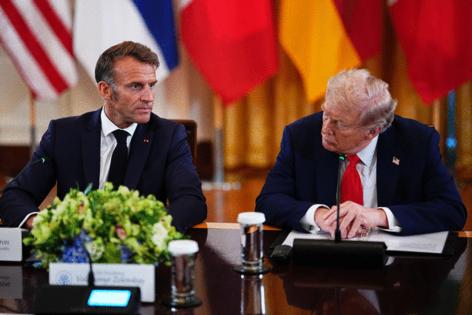
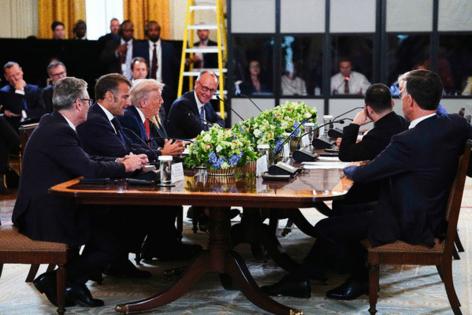
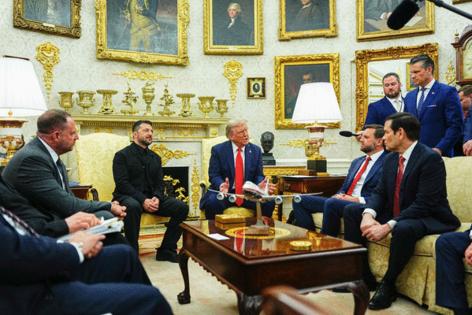
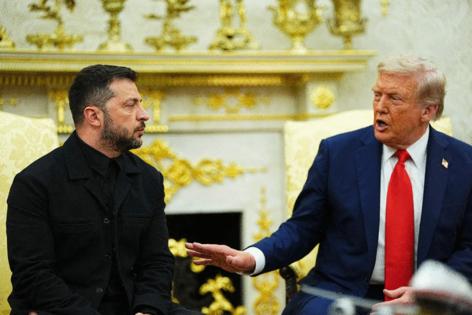
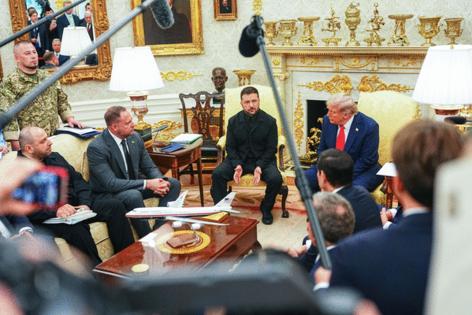





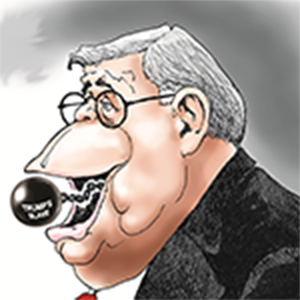
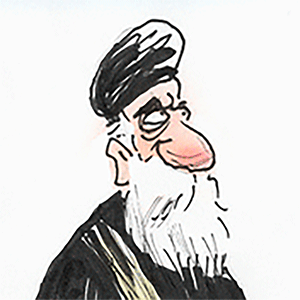

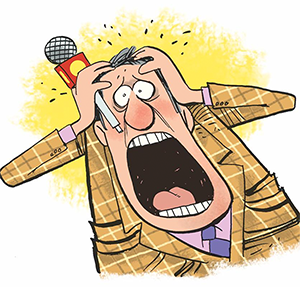
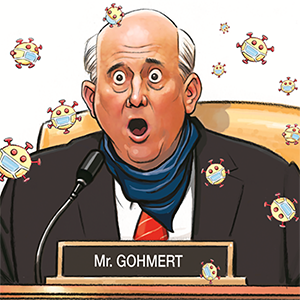

Comments